
William Morris was a British textile designer, poet, artist, fantasy writer, and socialist activist associated with the British Arts and Crafts movement. He was a major contributor to the revival of traditional British textile arts and methods of production. His literary contributions helped to establish the modern fantasy genre, while he helped win acceptance of socialism in fin de siècle Great Britain.
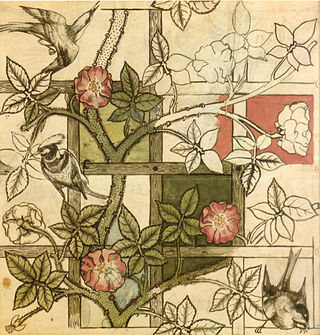
The Arts and Crafts movement was an international trend in the decorative and fine arts that developed earliest and most fully in the British Isles and subsequently spread across the British Empire and to the rest of Europe and America.

Mackay Hugh Baillie Scott was a British architect and artist. Through his long career, he designed in a variety of styles, including a style derived from the Tudor, an Arts and Crafts style reminiscent of Voysey and later the Neo-Georgian.
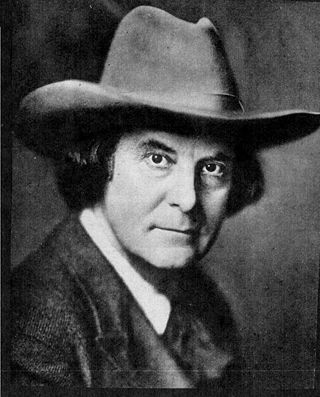
Elbert Green Hubbard was an American writer, publisher, artist, and philosopher. Raised in Hudson, Illinois, he had early success as a traveling salesman for the Larkin Soap Company. Hubbard is known best as the founder of the Roycroft artisan community in East Aurora, New York, an influential exponent of the Arts and Crafts movement.
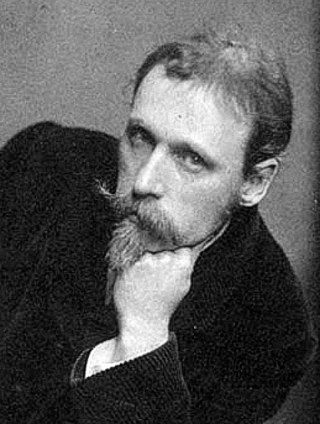
Walter Crane was an English artist and book illustrator. He is considered to be the most influential, and among the most prolific, children's book creators of his generation and, along with Randolph Caldecott and Kate Greenaway, one of the strongest contributors to the child's nursery motif that the genre of English children's illustrated literature would exhibit in its developmental stages in the later 19th century.
Private press publishing, with respect to books, is an endeavor performed by craft-based expert or aspiring artisans, either amateur or professional, who, among other things, print and build books, typically by hand, with emphasis on design, graphics, layout, fine printing, binding, covers, paper, stitching, and the like.

The Kelmscott Press, founded by William Morris and Emery Walker, published 53 books in 66 volumes between 1891 and 1898. Each book was designed and ornamented by Morris and printed by hand in limited editions of around 300. Many books were illustrated by Edward Burne-Jones. Kelmscott Press books sought to replicate the style of 15th-century printing and were part of the Gothic revival movement. Kelmscott Press started the contemporary fine press movement, which focuses on the craft and design of bookmaking, often using hand presses. While their most famous books are richly decorated, most Kelmscott Press books did not have elaborate decoration, but were published simply.

Morris, Marshall, Faulkner & Co. (1861–1875) was a furnishings and decorative arts manufacturer and retailer founded by the artist and designer William Morris with friends from the Pre-Raphaelites. With its successor Morris & Co. (1875–1940) the firm's medieval-inspired aesthetic and respect for hand-craftsmanship and traditional textile arts had a profound influence on the decoration of churches and houses into the early 20th century.

A rubric is a word or section of text that is traditionally written or printed in red ink for emphasis. The word derives from the Latin: rubrica, meaning red ochre or red chalk, and originates in medieval illuminated manuscripts from the 13th century or earlier. In these, red letters were used to highlight initial capitals, section headings and names of religious significance, a practice known as rubrication, which was a separate stage in the production of a manuscript.

Roycroft was a reformist community of craft workers and artists which formed part of the Arts and Crafts movement in the United States. Elbert Hubbard founded the community in 1895, in the village of East Aurora, New York, near Buffalo. Participants were known as Roycrofters. The work and philosophy of the group, often referred to as the Roycroft movement, had a strong influence on the development of American architecture and design in the early 20th century.
Book Art is a field of art that involves the creation of works that use or refer to the structural and conceptual properties of books. The term is also used to describe works of art produced in this field. These works may contain text, images, or both, or they may be sculptural. Book art has existed for thousands of years, and can be seen, for example, in Egyptian papyri, in Chinese, Japanese and Korean scrolls and books, and in Mesoamerican codices. As a field of contemporary art, book art has seen explosive growth since the 1960s. The related term "book arts" refers to the creative and craft disciplines used to produce book art, such as printing, printmaking, papermaking, typography and bookbinding.

The Ashendene Press was a small private press founded by St John Hornby (1867–1946). It operated from 1895 to 1915 in Chelsea, London and was revived after the war in 1920. The press closed in 1935. Its peers included the Kelmscott Press and the Doves Press. Hornby became friends with William Morris and Emery Walker, who helped inspire his work. These three presses were part of a "revival of fine printing" that focused on treating bookmaking as fine art. The Ashendene Press was famous for producing high-quality works by Dante. Ashendene books had excellent bindings and focused more on pleasure than reform than the other private presses of the time, though one review claims that the Ashendene Press was the most successful private press in recapturing the essence of fifteenth-century printing. Ashendene books were carefully printed with large margins, and despite their lack of extravagant decoration, they were considered spectacular works of art. Two original typefaces were created for the Ashendene Press: Subiaco and Ptolemy. They were known for handwritten, colored initials by Graily Hewitt. The press' main customers were book collectors who paid for a subscription for Ashendene books.
Daniel Berkeley Updike was an American printer and historian of typography. In 1880 he joined the publishers Houghton, Mifflin & Company, of Boston as an errand boy. He worked for the firm's Riverside Press and trained as a printer but soon moved to typographic design. In 1896 he founded the Merrymount Press.
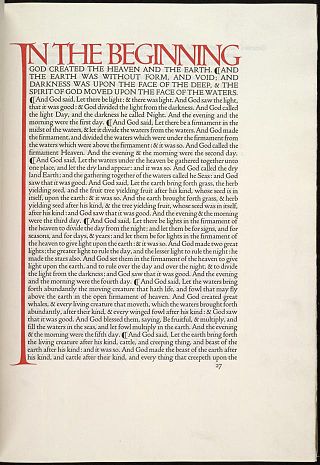
The Doves Press was a private press based in Hammersmith, London. During nearly seventeen years of operation, the Doves Press produced notable examples of twentieth-century typography. A distinguishing feature of its books was a specially-devised typeface, known variously as the Doves Roman, the Doves Press Fount of Type, or simply the Doves Type.
The Story of the Glittering Plain is an 1891 fantasy novel by William Morris, perhaps the first modern fantasy writer to unite an imaginary world with the element of the supernatural, and thus the precursor of much of present-day fantasy literature. It is also important for its exploration of the socialist themes that interested Morris.
Violet De Mars Trovillion (1890–1979) and Hal W. Trovillion (1879–1967) were publishers based in Herrin, Illinois who operated local newspapers and a private press known as Trovillion Private Press at the Sign of the Silver Horse or simply Trovillion Press.

Edmund Hort New was an English artist, member of the Birmingham Group, and leading illustrator of his day.

Chants for Socialists is the eleventh solo studio album by English singer/songwriter Darren Hayman. It was released by WIAIWYA Records on 2 February 2015.
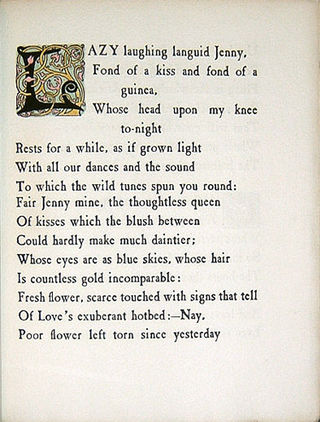
Helen Van Vechten (1868–1949) was an American printer who became known for the hand-printed fine press books she produced for the Philosopher Press in Wisconsin around the turn of the 20th century. In her day, she was one of very few women involved in fine book-making in America and was regarded as a top expert in the field.

The Golden Type is a serif font designed by artist William Morris for his fine book printing project, the Kelmscott Press, in 1890. It is an "old-style" serif font, based on type designed by engraver and printer Nicolas Jenson in Venice around 1470. It is named for the Golden Legend, which was intended to be the first book printed using it. The original design has neither an italic nor a bold weight, as neither of these existed in Jenson's time.














